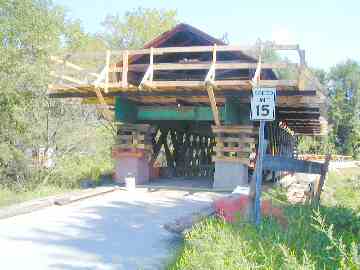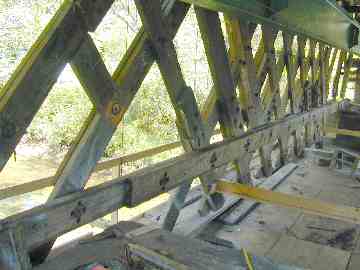|
Cooley Bridge Rehab Underway
WGN 45-11-07
August 19, 2003 - A startling sight, the bridge stands supported by cribbing as work goes
forward on the trusses and floor system. The work is being funded by the National Covered
Bridge Preservation Program, the State of Vermont, and the town of Pittsford.
The rehabilitation of the Cooley Bridge has begun and
is well underway. The contractor is Neil Daniels Construction of Ascutney, Vt., the foreman,
Tony Daniels. Daniels Construction was the prime contractor for the new Mill Bridge in
Tunbridge, and the stabilization phase of the Poland Bridge in Cambridge Junction.

|

|
A startling sight, the bridge stands supported by
cribbing as work goes forward.
Photo by Joe Nelson, August 19, 2003
|
The lower bottom chord has been removed as the floor system is renewed.
Original fabric will be retained as much as possible.
Photo by Joe Nelson, August 19,
2003
|
The following notes were taken from the January 2002 Inspection Report by Lichtenstein
Consulting Engineers, Inc., Watertown Ct.:
The Cooley Covered Bridge is located in the town of Pittsford, Vermont. Built in 1849 [by
Nicholas Powers], it is one of four covered bridges remaining in Pittsford. The structure is a 50
foot single span, Town Lattice timber truss supported by laid up stone abutments faced with
reinforced concrete. The structure carries Elm Street, a class 3 town highway, over Furnace
Brook. According to the Covered Bridge Study Report (May 1995), the structural capacity of the
bridge, when in "good" condition, is adequate to support vehicle loads at 16,000 pounds.
EXISTING CONDITIONS AND FINDINGS: In general, the bridge and its components
were in fair condition. Notable deficiencies of the superstructure are as follows:
- Both trusses were inspected for plumbness:
- The bottom chord of the west truss is bowed 1.5" from mid span to the south end.
- At the northwest corner, the top chord of the truss was leaning to the east 3" over 12'
- There was no leaning of the northeast corner.
- At the southeast corner, the top chord is leaning to the east 8" over 12'
- At the southwest corner, the top chord is leaning to the east 9" over 12'
- Rot and decay were noted at the ends of the bottom chords, typically the lower exterior and
interior members of the bottom chord exhibited the most extensive deterioration
- There are a few random diagonals that have areas of rot on the ends
- There are nine 14" x 8" floorbeams, spaced 4'-0" center to center, that were found in good
condition.
Deficiencies observed of the siding and roof are as follows:
- The roof sheathing boards were found in fair condition with only a few areas of rot.
- There was evidence of leakage through the roof and light was visible through one or two
holes
- The siding is in poor condition with warping, checks, and splits throughout and rotted areas
near the bottom
Deficiencies that were observed and noted on the deck and approaches are as follows:
- As stated in the September 19, 2000 VT DOT inspection report, it was observed that the top
of the deck has moderate wear along the surface as do the plank runners
- The runners had small sections broken out along their edges as well as some minor rot
- Approaching the bridge from the north and south, the wooden approach guardrails are
substandard with the posts leaning heavily away from the roadway
- Photographs from previous VTRANS inspections show that vegetation is growing directly
adjacent to the west side of the bridge
Deficiencies that were observed and noted on the substructure are as follows:
- There are random cracks, stains and minor honeycombing
- The footing of this abutment is partially exposed,
- At the bottom southeast corner there is a honeycombing area which measures 2'x 8" x 2"deep
- At the top there is a spall measuring 2' x 3' x 1' deep with exposed rebar.
RECOMMENDATIONS:
Overall, the superstructure is in fair condition. The following items should be considered to
improve the structural integrity and improve the structure for continued vehicular use.
The trusses were found to have minor deficiencies with only limited repairs required.
Suggested repairs to the trusses are:
- Remove and replace 10' of the lower exterior bottom chord member at all four corners
- Straighten the 'racking' at the south end of the structure, this will include the temporary
removal and reinstallation of the top chord struts and knee braces and the strengthening of the
connections of these members to prevent racking in the future
- Add 'sister' members for lattice members as required
- Replace the bearing block at all locations
- Application of a fungicide/insecticide on all remaining timber
- spray/brush application on all exposed surfaces of members to remain
- fumigant application in drilled holes to arrest ongoing rot and insect damage and to prevent
future damage, made at the ends of all truss members
- Application of preservative/sealant treatment
- Application of a Class A fire retardant on all existing timber that is to remain
The deck, floorbeams and distribution beams were also found to have minor deficiencies.
However, the structural capacity of the floorbeams is less than desirable. Suggested repairs for
these members are:
- Replacement of the deck with a 5 1/2" thick nail laminated timber deck
- Replacement of the floorbeams with similar timber members of higher strength will
increase the capacity to approximately 10.7 tons
There are other non-structural items that should be addressed to continue to protect the structure
for best long term preservation. These include:
- Replace and paint all the siding
- Repair of the slate roof including washing away the moss and lichen
- Cleaning and painting of the bottom chord lateral bracing (steel rods)
- Installation of adequate approach railing
- Improved approach signing
- Remove and replace deteriorated concrete at spall on south abutment
- Install bridge lighting
Additional minor alterations should be made to the structure so as help protect the structure from
future deterioration. These include leaving space between the timber members and concrete of the
abutments so that water and debris are not trapped, installation of materials that deflect or help
drain away water and debris from elements below roadway level and treatment of all new timber
elements with fire retardant. A fire alarm system can also be considered with a direct link to local
fire and police departments. The estimated cost for these repairs is approximately $190,000.
|
 Joe Nelson, P.O Box 267, Jericho, VT 05465-0267
This file posted August 23, 2003
Joe Nelson, P.O Box 267, Jericho, VT 05465-0267
This file posted August 23, 2003

